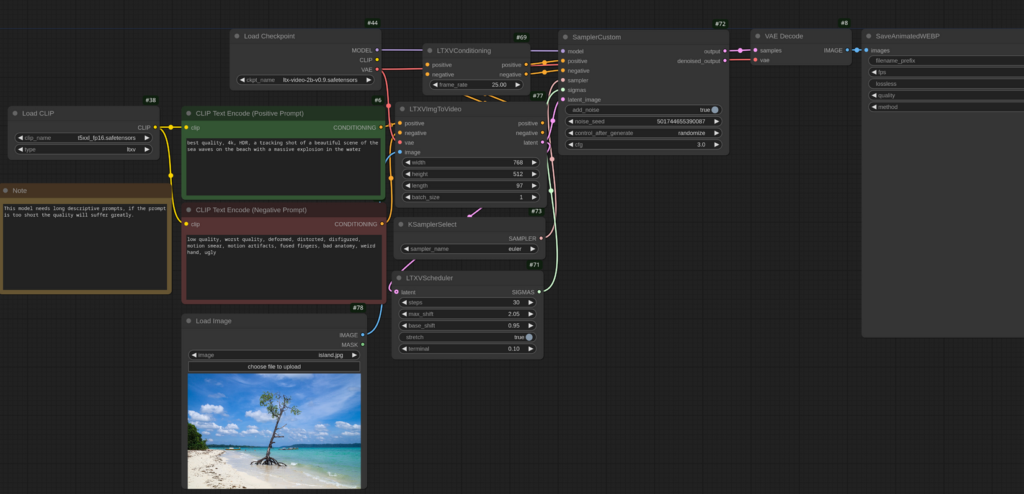Open-Source Innovation: Lightricks’ LTXV Model Transforms Video Creation

Lightricks has introduced LTX Video (LTXV), an open-source AI model that is set to transform video generation. This innovative technology can produce high-quality videos in real-time, generating 5 seconds of 768×512 resolution video at 24 FPS in just 4 seconds. LTXV’s 2-billion-parameter DiT-based architecture ensures efficiency and quality, optimized for consumer-grade hardware like the Nvidia RTX 4090. The model’s open-source nature and integration with platforms like ComfyUI democratize advanced video creation tools. With applications ranging from gaming to e-commerce, LTXV promises to revolutionize content creation across various industries, offering speed, accessibility, and high-quality outputs to creators and businesses alike.
Introduction to LTX Video (LTXV)
Lightricks, the Israeli company renowned for its viral photo-editing app Facetune, has unveiled a groundbreaking open-source AI model called LTX Video (LTXV)¹. This innovative technology marks a significant leap forward in the field of open-source generative AI, particularly in video creation. LTXV is designed to generate high-quality videos in real-time, challenging the dominance of proprietary AI systems from tech giants and democratizing access to advanced video generation tools.
The introduction of LTXV comes at a time when the AI landscape is rapidly evolving, with a growing emphasis on open-source solutions. Lightricks’ decision to make LTXV freely available is a strategic move aimed at fostering innovation and adoption across various sectors, from academia to commercial applications. This approach aligns with the company’s belief that foundational models will become commoditized, necessitating open access to technology for startups and researchers to compete effectively in the AI space.
Technical Specifications and Capabilities
At its core, LTXV is a 2-billion-parameter DiT-based model that showcases remarkable efficiency and quality in video generation. The model is capable of producing videos at a resolution of 768×512 pixels with a frame rate of 24 FPS. What sets LTXV apart is its ability to generate 5 seconds of high-quality video in just 4 seconds, surpassing real-time playback speeds.
This exceptional performance is achieved without compromising on visual fidelity or motion consistency. The model’s architecture ensures smooth transitions between frames, addressing common issues in video generation such as object morphing and flickering. LTXV is designed to maintain precision and visual quality while optimizing for speed and memory efficiency, making it suitable for consumer-grade hardware like the Nvidia RTX 4090.
At the heart of LTXV lies the Diffusion Transformer (DiT) architecture, a novel approach that combines the power of diffusion models with the versatility of transformers ² ³. DiT operates on latent patches, replacing the traditional U-Net backbone commonly used in diffusion models. This architecture has shown remarkable scalability, with performance improving as the model’s complexity (measured in Gflops) increases through greater transformer depth/width or a higher number of input tokens. The effectiveness of DiT has been demonstrated in image generation tasks, where larger DiT models have achieved state-of-the-art results on class-conditional ImageNet benchmarks, setting new standards for image quality and fidelity.
The model’s scalability is another key feature, allowing for the generation of longer-form videos without sacrificing quality. This opens up new possibilities for storytelling and content creation across various industries, from entertainment to marketing.
Integration with ComfyUI and Accessibility
One of the most significant aspects of LTXV’s release is its native support in ComfyUI ⁴, an open-source graphical interface for Stable Diffusion. This integration provides creators with a flexible, node-based workflow for precise control over the video generation process. Lightricks has developed custom nodes branded as “LTXVideo” specifically for ComfyUI, which are readily available through the ComfyUI Manager.
The installation process for LTXV within ComfyUI is straightforward, requiring users to update to the latest version of ComfyUI, download the LTXV model file, and ensure the presence of the T5 XXL Encoder. This seamless integration allows creators to quickly adapt to the new technology and incorporate it into their existing workflows.
LTXV’s accessibility extends beyond its integration with ComfyUI. The model is designed to run efficiently on widely available GPUs, making it accessible to a broader audience of creators, from hobbyists to professional studios. This democratization of advanced video generation tools has the potential to revolutionize content creation across various industries.

Applications and Industry Impact
The introduction of LTXV has far-reaching implications for multiple industries. In the gaming sector, LTXV could be used to upscale graphics in older games, transforming them into visually stunning experiences. For e-commerce, the model’s speed and efficiency could enable businesses to create thousands of ad variations for targeted A/B testing, significantly enhancing marketing strategies.
The film and entertainment industry stands to benefit greatly from LTXV’s capabilities. The ability to generate high-quality video content quickly and efficiently could streamline pre-visualization processes, concept development, and even assist in post-production tasks. Additionally, the model’s real-time generation capabilities open up new possibilities for interactive media and live content creation.
In the field of education and research, LTXV’s open-source nature provides academics and developers with a powerful tool to explore and advance video AI technology. This could lead to breakthroughs in areas such as computer vision, motion analysis, and automated video editing.
Open-Source Strategy and Future Outlook
Lightricks’ decision to release LTXV as an open-source model is a calculated move in an increasingly competitive AI landscape. By making the technology freely available, the company aims to foster innovation and adoption across various sectors. This approach is reminiscent of Meta’s release of its open-source Llama language models, which quickly gained traction in the AI community.
The open-source nature of LTXV invites collaboration and continuous evolution of the technology. Lightricks has released the model on platforms such as GitHub ⁵, Hugging Face, and fal.ai under an Apache License 2.0, ensuring that derivatives remain open for academic and commercial use. This strategy not only benefits the wider AI community but also positions Lightricks as a key player in shaping the future of AI video technology.
Looking ahead, the success of LTXV could pave the way for a new paradigm in AI development, where openness and collaboration become key competitive advantages. As the model continues to evolve through community contributions and academic research, it has the potential to drive significant advancements in video generation technology.
Conclusion
LTX Video (LTXV) represents a significant leap forward in AI-powered video generation. Its combination of speed, quality, and accessibility has the potential to revolutionize content creation across multiple industries. By making this technology open-source, Lightricks has not only challenged the status quo of proprietary AI systems but also opened up new possibilities for innovation and collaboration in the field of video AI.
As LTXV continues to evolve and find applications in various sectors, it will likely play a crucial role in shaping the future of video content creation. The model’s impact extends beyond its technical capabilities, embodying a shift towards more open and collaborative approaches in AI development. As creators, developers, and researchers explore the full potential of LTXV, we can expect to see a new wave of creative and technological innovations in the realm of AI-generated video content.
Sources: